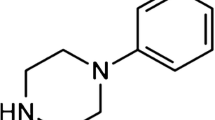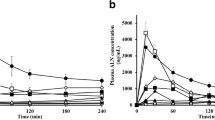Abstract
Purpose
Although pharmaceutical excipients do not affect the membrane permeation of active drugs, some have been shown to influence absorption-regulating factors. However, limited information is currently available on the effects of pharmaceutical excipients on membrane permeation via passive transcellular transport, which is the main membrane permeation route of many drugs.
Methods
We herein focused on polyvinylpyrrolidone (PVP) (K90), which is used as a diluent and binder in pharmaceutical formulations, and examined its effects on passive transport via the transcellular route in the rat jejunum using the in vitro sac method.
Results
The membrane permeation of β-naphthol, a passive transcellular marker, was increased by the co-existence of 0.02 w/v % PVP (K90). However, PVP (K90)-induced increases in membrane permeation were not observed following a pre-incubation with PVP (K90). Therefore, PVP (K90)-induced increases in membrane permeation may be attributed to a drug-excipient interaction, but not a mucosal membrane-excipient interaction.
Conclusion
PVP (K90) affected membrane transport via the transcellular route in the rat jejunum. However, since the coexistence of PVP (K90) did not influence membrane protein expression levels or cause membrane lesions, the absorption of active drugs may be regulated by the optimal application of PVP (K90).





Similar content being viewed by others
References
Bromberg L, Alakhov V (2003) Effects of polyether-modified poly (acrylic acid) microgels on doxorubicin transport in human intestinal epithelial Caco-2 cell layers. J Control Release 88:11–22
Collnot EM, Baldes C, Wempe MF, Kappl R, Hüttermann J, Hyatt JA, Edgar KJ, Schaefer UF, Lehr CM (2007) Mechanism of inhibition of P-glycoprotein mediated efflux by vitamin E TPGS: influence on ATPase activity and membrane fluidity. Mol Pharm 4:465–474
Cornaire G, Woodley J, Hermann P, Cloarec A, Arellano C, Houin G (2004) Impact of excipients on the absorption of P-glycoprotein substrates in vitro and in vivo. Int J Pharm 278:119–131
Kavimandan NJ, Losi E, Peppas NA (2006) Novel delivery system based on complexation hydrogels as delivery vehicles for insulin-transferrin conjugates. Biomaterials 27:3846–3854
Kim YS, Ho SB (2010) Intestinal goblet cells and mucins in health and disease: recent insights and progress. Curr Gastroenterol Rep 12:319–330
Kimura T, Sudo K, Kanzaki Y, Miki K, Takeichi Y, Kurosaki Y, Nakayama T (1994) Drug absorption from large intestine: physicochemical factors governing drug absorption. Biol Pharm Bull 17:327–333
Moniaux N, Escande F, Porchet N, Aubert JP, Batra SK (2001) Structural organization and classification of the human mucin genes. Front Biosci 6:D1192–D1206
Papadimitriou SA, Barmpalexis P, Karavas E, Bikiaris DN (2012) Optimizing the ability of PVP/PEG mixtures to be used as appropriate carriers for the preparation of drug solid dispersions by melt mixing technique using artificial neural networks: I. Eur J Pharm Biopharm 82:175–186
Schütte A, Ermund A, Becker-Pauly C, Johansson ME, Rodriguez-Pineiro AM, Bäckhed F, Müller S, Lottaz D, Bond JS, Hansson GC (2014) Microbial-induced meprin β cleavage in MUC2 mucin and a functional CFTR channel are required to release anchored small intestinal mucus. Proc Natl Acad Sci USA 111:12396–12401
Takizawa Y, Kishimoto H, Nakagawa M, Sakamoto N, Tobe Y, Furuya T, Tomita M, Hayashi M (2013) Effects of pharmaceutical excipients on membrane permeability in rat small intestine. Int J Pharm 453:363–370
Yamagata T, Kusuhara H, Morishita M, Takayama K, Benameur H, Sugiyama Y (2007a) Improvement of the oral drug absorption of topotecan through the inhibition of intestinal xenobiotic efflux transporter, breast cancer resistance protein, by excipients. Drug Metab Dispos 35:1142–1148
Yamagata T, Kusuhara H, Morishita M, Takayama K, Benameur H, Sugiyama Y (2007b) Effect of excipients on breast cancer resistance protein substrate uptake activity. J Control Release 124:1–5
Yamagata T, Kusuhara H, Morishita M, Takayama K, Benameur H, Sugiyama Y (2009) Characterization of the inhibition of breast cancer resistance protein-mediated efflux of mitoxantrone by pharmaceutical excipients. Int J Pharm 370:216–219
Acknowledgements
The present study was supported in part by a Grant-in-Aid for Young Scientists (B) (25860127) from the Japan Society for the Promotion of Sciences (JSPS).
Author information
Authors and Affiliations
Corresponding author
Ethics declarations
Conflict of interest
The authors state that they have no conflict of interest.
Ethical approval
All animal experiments were performed according to the guidelines of the Tokyo University of Pharmacy and Life Sciences. The study was approved by the Tokyo University of Pharmacy and Life Sciences Committee on the Care and Use of Laboratory Animals (approval number: P13-42 and P14-69).
Additional information
Publisher's Note
Springer Nature remains neutral with regard to jurisdictional claims in published maps and institutional affiliations.
Rights and permissions
About this article
Cite this article
Takizawa, Y., Furuno, Y. & Hayashi, M. Effects of polyvinylpyrrolidone (K90) on membrane permeation via the transcellular route in the rat jejunum. J. Pharm. Investig. 51, 311–316 (2021). https://doi.org/10.1007/s40005-021-00514-2
Received:
Accepted:
Published:
Issue Date:
DOI: https://doi.org/10.1007/s40005-021-00514-2




